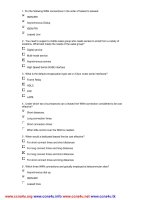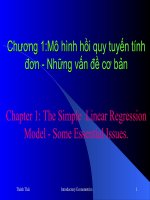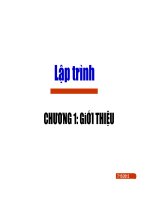- Trang chủ >>
- Sư phạm >>
- Sư phạm toán
Chapter1 2
Bạn đang xem bản rút gọn của tài liệu. Xem và tải ngay bản đầy đủ của tài liệu tại đây (496.2 KB, 54 trang )
Holomorphic Functions
BLEL Mongi
Department of Mathematics
King Saud University
2016-2017
BLEL Mongi Holomorphic Functions
Definition
Let f : Ω −→ C be a function defined on a non empty open set Ω.
1. We say that f is differentiable at z ∈ Ω if there exists ∈ C
such that
lim f (w ) − f (z) = lim f (z + h) − f (z) =.
z→a w − z h→0,h∈C∗ h
We denote = f (z) and called the derivative of f at z.
2. We say that f is holomorphic on Ω if f is differentiable at any
point of Ω.
We denote H(Ω) the set of holomorphic functions on Ω.
BLEL Mongi Holomorphic Functions
Examples
1. The function f (z) = zn is holomorphic on C, for every n ∈ N.
2. The function f (z) = z¯ is not differentiable at any point of C
because z + h − z¯ h¯ h¯
= and lim does not exit.
h h h→0 h
3. If f : Ω −→ C is a holomorphic function, then the function f ∗
defined by f ∗(z) = f (z¯) is holomorphic on Ω = {z¯; z ∈ Ω},
indeed If z, a ∈ Ω,
lim f ∗(z) − f ∗(a) = lim f (z¯) − f (a¯) = f (a¯).
z→a z − a z→a z¯ − a¯
BLEL Mongi Holomorphic Functions
Proposition (Exercise)
1. If f and g are holomorphic on Ω, then f + g , fg are also
holomorphic on Ω.
The function f is holomorphic on the open set where g does
g
not vanishes.
2. If f : Ω1 −→ C is a holomorphic function and g : Ω2 −→ C is
a holomorphic function such that g (Ω2) ⊂ Ω1, then f ◦ g is
holomorphic on Ω2 and (f ◦ g ) (z) = f (g (z))g (z).
BLEL Mongi Holomorphic Functions
Theorem (Cauchy-Riemann conditions)
Let f (z) = U(x, y ) + iV (x, y ) be a function defined on a
neighborhood of z0 = x0 + iy0. (U = f and V = f ). We
assume that the functions U and V are differentiable at (x0, y0).
Then the function f of complex variable z = x + iy is differentiable
at z0, if and only if
∂U (x ∂V 0, y0) = (x0, y0)
∂x ∂y
. (1)
∂U (x ∂V 0, y0) = − (x0, y0)
∂y ∂x
BLEL Mongi Holomorphic Functions
These conditions are called the Cauchy-Riemann conditions. They
are equivalent to the following condition
∂f ∂f
∂y (z0) = i ∂x (z0). (2)
BLEL Mongi Holomorphic Functions
Proof
Necessary condition
If f is differentiable at z0 = x0 + iy0, then
limh→0 h f (z0+h)−f (z0) = f (z0). If we take the limit when h tends to
0, h real, we have
f (z0) = lim U(x0 + h, y0) − U(x0, y0) + i V (x0 + h, y0) − V (x0, y0)
h→0 h h
∂U ∂V ∂f
= ∂x (x0, y0) + i ∂x (x0, y0) = ∂x (x0 + iy0). (3)
BLEL Mongi Holomorphic Functions
If we take the limit when h = it, with t real, we have
f (z0) = lim U(x0, y0 + t) − U(x0, y0) + i V (x0, y0 + t) − V (x0, y0)
t →0 h it
∂U ∂V ∂f
= −i ∂y (x0, y0) + ∂y (x0, y0) = −i ∂y (z0). (4)
We have then the Cauchy-Riemann conditions.
Sufficient condition
By definition of the differentiability of function of two real
variables, we have
U(x ∂U ∂U 0 + s, y0 + t) − U(x0, y0) = s (x0, y0) + t (x0, y0) + |h|ε1(h)
∂x ∂y
V (x ∂V ∂V 0 + s, y0 + t) − V (x0, y0) = s (x0, y0) + t (x0, y0) + |h|ε2(h)
∂x ∂y
BLEL Mongi Holomorphic Functions
with h = s + it, limh→0 ε1(h) = limh→0 ε2(h) = 0. Thus
∂U ∂U ∂V ∂V
f (z0+h)−f (z0) = s ∂x (x0, y0)+t ∂y (x0, y0)+i s ∂x (x0, y0)+t ∂y (x0, y0
with ε = ε1 + iε2.
BLEL Mongi Holomorphic Functions
It follows by Cauchy-Riemann conditions that
f (z0 + h) − f (z0) = Ah + |h|η(h),
∂U ∂V
with A = ∂x (x0, y0) + i ∂x (x0, y0) and η(h) tends to 0 when h
tends to 0. Thus f is differentiable at z0 and f (z0) = A.
BLEL Mongi Holomorphic Functions
Remark (Riemann 1851)
If U and V are two functions twice continuously differentiable on
an open subset Ω of C and if f = U + iV is holomorphic on Ω,
∂2U ∂2U
then ∆U = ∆V = 0, with ∆U = ∂x2 + ∂y 2 . (∆ is called the
Laplace operator). We say that U and V are harmonic.
BLEL Mongi Holomorphic Functions
Corollary
If f is holomorphic on Ω, then
∂f ∂f
f (z) = (x, y ) = −i (x, y )
∂x ∂y
∂U ∂V ∂V ∂U
= (x, y ) + i (x, y ) = (x, y ) − i (x, y )
∂x ∂x ∂y ∂y
∂U ∂U ∂V ∂V
= (x, y ) − i (x, y ) = (x, y ) + i (x, y ),
∂x ∂y ∂y ∂x
where z = x + iy .
BLEL Mongi Holomorphic Functions
Example
Determine the holomorphic functions f : C −→ C such that
f (z) = U(x, y ) = x2 − y 2 − 2xy .
∂V
Let V = f , then by Cauchy-Riemann conditions, = 2x − 2y ,
∂y
thus V = 2xy − y 2 + g (x). Furthermore
∂V
= 2y + g (x) = −(−2y − 2x) = 2x + 2y , thus
∂x
V = x2 − y 2 + 2xy + C and f (z) = (1 + i)z2 + iC .
BLEL Mongi Holomorphic Functions
Example
Determine the holomorphic functions f : C −→ C such that
f (z) = x3 − 3xy 2 − 2xy − 1.
If V = f , then ∂V = 3x2 − 3y 2 − 2y , thus
∂y
V = 3x2y − y 3 − y 2 + g (x). Furthermore
∂V = 6xy + g (x) = 6xy + 2x, thus V = 3x2y − y 3 − y 2 + x2 + C .
∂x
f (z) = ∂f = 3x2 − 3y 2 − 2y + i(6xy + 2x) =
∂x
3(x2 − y 2 + 2ixy ) + 2i(x + iy ) = 3z2 + 2iz. Thus
f (z) = z3 + iz2 + 1 + ic, where c ∈ R.
BLEL Mongi Holomorphic Functions
Proposition
Let f be a holomorphic function on a domain Ω. Then
f ≡ 0 on Ω ⇐⇒ f is constant on Ω.
Proof
The sufficient condition is trivial. For the necessary condition, it
suffices to show that f is locally constant. Let z0 ∈ Ω and r > 0
such that D(z0, r ) ⊂ Ω. Let z1 ∈ D(z0, r ), the complex number
∂f
z2 = z1 + i z0 ∈ D(z0, r ) and f (z0) = f (z2) because ∂x = 0
∂f
and f (z2) = f (z1) because ∂y = 0, thus f (z0) = f (z1).
BLEL Mongi Holomorphic Functions
Proposition
Let f : Ω −→ C be a holomorphic function on a domain Ω of C.
Then the following properties are equivalent.
1. f is constant on Ω.
2. f is constant on Ω.
3. f is constant on Ω.
4. |f | is constant on Ω.
5. f¯ is holomorphic on Ω.
BLEL Mongi Holomorphic Functions
Proof
• It is obvious that 1) ⇒ 2).
• By The Cauchy-Riemann conditions (1), 2) ⇐⇒ 3).
Since 2) ⇐⇒ 3), then 3) ⇒ 4).
• If |f | = 0, then f¯ is holomorphic on Ω.
If |f | = c = 0, then f f¯ = c and f = c is holomorphic on Ω. 2
f
• f¯ is holomorphic on Ω. In use the Cauchy-Riemann conditions
for f and f¯, we find f is constant.
BLEL Mongi Holomorphic Functions
Theorem
Let f be the holomorphic function defined by the power series
anzn which admits R > 0 as radius of convergence, then the
n≥0
function g defined by the power series nanzn−1 admits R as
n≥1
radius of convergence. The function f is holomorphic on D(0, R)
and f (z) = g (z).
BLEL Mongi Holomorphic Functions
For the proof of this theorem, we need the following lemma
Lemma
Let z ∈ C and h ∈ C such that 0 < |h| ≤ r , then for all n ∈ N∗
nn n−1 |h|2 n
|(z + h) − z − nhz | ≤ 2 (|z| + r ) (5)
r
and n|z|n−1 ≤ 1 2(|z| + r )n + |z|n
r (6)
BLEL Mongi Holomorphic Functions
Proof
By inequality (5)
n
(z + h)n − zn − nhzn−1 = C kn hk z n−k − z n − nhz n−1
k =0
n
= C kn hk z n−k
k =2
n
≤ |h|2 C kn |z|n−k |h|k−2
k =2
|h|2 k n−k k n |h|2 n
≤ 2 Cn |z| r ≤ 2 (|z| + r ) .r r
k =2
We have |(z + h)n − zn − nhzn−1| ≥ nr |z|n−1 − |z|n − (|z| + r )n.
By (5), we deduce
BLEL Mongi Holomorphic Functions









